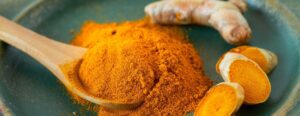
Turmeric is a bright, golden-orange spice that adds color, flavor, and nutrition to food. It comes from the root of a plant related to ginger and has been used in cooking for hundreds of years. It is also used in traditional medicine in countries like China and India.
Mary-Eve Brown, a clinical dietitian/nutritionist at Johns Hopkins Medicine, shares information about turmeric’s health benefits, how to use it in cooking, and two recipes that include this spice.
What is turmeric good for?
Brown explains that the main active ingredient in turmeric is curcumin, a natural compound with both antioxidant and anti-inflammatory properties.
“Curcumin has many effects on the body, but not all of them are fully understood,” says Brown. “Like other colorful plant-based foods, turmeric is full of phytonutrients that help protect the body by neutralizing free radicals (from pollution and sunlight) and preventing cell damage.” Diets that include plant-based foods are linked to preventing diseases like cancer and heart disease.
Brown adds, “People who are dealing with inflammation can benefit from adding turmeric to their meals.” Conditions like arthritis, joint pain, colitis, allergies, and infections can be helped by turmeric.
Science Behind Turmeric
Turmeric and curcumin have been studied by scientists.
“Some studies show that people with osteoarthritis felt less joint pain when they ate turmeric,” says Brown. “Research has also looked at how turmeric might affect mood disorders, depression, and dementia, but these studies are small, so more research is needed to see if there is a real benefit.”
Turmeric may also help with:
-
Inflammation
-
Eye conditions
-
Metabolic syndrome
-
Arthritis
-
High cholesterol
-
Anxiety
-
Muscle soreness after exercise
-
Kidney health
Turmeric Supplements
Brown suggests that turmeric supplements may not be a good idea. While turmeric is nutritious, taking too much curcumin can be harmful.
Turmeric supplements can increase the risk of kidney stones, especially for people with a family history of them. Curcumin in supplements is much more concentrated than what you get from food or turmeric tea.
“One issue with turmeric is that curcumin is not easily absorbed by the body. It gets broken down quickly during digestion,” says Brown.
To get the benefits safely, it’s best to add turmeric to your meals. Combining turmeric with black pepper may help the body absorb it better. A substance in black pepper called piperine can increase the absorption of curcumin by 2000%.
Brown says, “It’s better to get curcumin from whole foods instead of pills or supplements.”
Turmeric Supplements and Drug Interactions
High doses of curcumin in supplements can affect certain medicines.
-
Pain relievers: Turmeric supplements can make painkillers like aspirin, ibuprofen, or acetaminophen less effective.
-
Chemotherapy: People undergoing chemotherapy should talk to their doctor before taking turmeric supplements. Some chemotherapy drugs may not work well with turmeric.
-
Blood thinners: Turmeric can increase the risk of bleeding for people on blood thinners like warfarin.
-
Immune-suppressing drugs: If you take tacrolimus, turmeric may cause side effects.
Turmeric Side Effects
Turmeric is safe for most people when used in food or tea. However, if you’re allergic to it, you might have skin reactions or stomach pain. Most side effects happen with high amounts of curcumin in supplements.
How to Enjoy Turmeric
Turmeric is used to color mustard and is a key ingredient in curry powder. Brown enjoys the earthy flavor of turmeric and uses it to add color and depth to Thai dishes, stews, chilis, and even chicken soup.
She buys fresh turmeric root, freezes it for up to six months, and uses it in cooking. Be careful, as turmeric stains countertops and fabrics. If needed, abrasive cleaners or chlorine-based products can remove the stains.
Turmeric Tea
You can make a soothing tea with turmeric, similar to ginger tea. Here’s Brown’s recipe:
-
2 tablespoons chopped turmeric root or 2 teaspoons turmeric powder
-
Bring 1–2 cups of water to a boil
-
Add turmeric and simmer for 5 minutes, then strain
-
You can enjoy it warm or cold and add lemon or honey for extra flavor.
Recipe: Curried Pumpkin Butternut Squash Creamy Vegan Soup
Ingredients
-
Olive oil
-
1 pound each pumpkin and butternut squash, peeled and diced
-
2 shallots, diced
-
2–3 tablespoons Thai red curry paste
-
2 tablespoons grated turmeric root or 2 teaspoons turmeric powder
-
4 cups vegetable stock or broth
-
1 can unsweetened coconut milk
-
Salt and pepper
Directions
-
Roast the pumpkin and butternut squash with olive oil, salt, and pepper at 400°F for 10 to 15 minutes, until fork tender.
-
In a large pot, sauté the shallots, curry paste, and turmeric in olive oil for 8 to 10 minutes until soft.
-
Add the vegetable broth and roasted pumpkin and squash. Simmer for at least 20 minutes.
-
Taste and adjust the flavor with salt, pepper, or more curry paste.
-
Add the coconut milk and simmer.
-
Blend the soup until smooth with an immersion blender or stand blender. Enjoy!